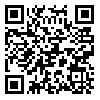BibTeX | RIS | EndNote | Medlars | ProCite | Reference Manager | RefWorks
Send citation to:
URL: http://johe.umsha.ac.ir/article-1-22-en.html

 , Mohsen Aliabadi
, Mohsen Aliabadi 
 , Yusuf Babayi Mesdaraghi
, Yusuf Babayi Mesdaraghi 
 , Maryam Farhadian
, Maryam Farhadian 
 , Mehdi Jalali *1
, Mehdi Jalali *1 
 , Behzad Kalantari
, Behzad Kalantari 
 , Mehdi MolaKazemiha
, Mehdi MolaKazemiha 

Background & Objectives : Exposure to high temperatures is common among workers in warm environments leading to some undesirable effects . The aim of this study was to examine physiological responses to heat stress to determine the optimal index for direct measurement of physiological strain in workers of hot environments .
Methods: In this study, 40 workers of melting and casting process were evaluated . Thermal stress was evaluated based on the WBGT index and physiological strain by measuring oral and tympanic temperature , urine temperature , heart rate, and recovery heart rate. Data was analyzed using SPSS v.16 software .
Results : Heat stress exceeded the national and international recommended limits based on the WBGT index in 80% of cases of workstations . The correlations between heat strains including tympanic temperature, oral temperature, urine temperature, heart rate and heart rate recovery to heat stress index were significant, while tympanic temperature had a stronger association according to simple linear regression (P<0.01, R2=0.78) .
Conclusion: Tympanic temperature had a stronger correlation with the WBGT index among the investigated indices . Accordingly , tympanic temperature could be a useful indicator compared to other parameters for measuring physiological strain in warm workplaces due to the ease of measurement, noninvasive nature , acceptance by workers , and fast and non- interference in the measurement process .
| Rights and permissions | |
 |
This work is licensed under a Creative Commons Attribution-NonCommercial 4.0 International License. |



